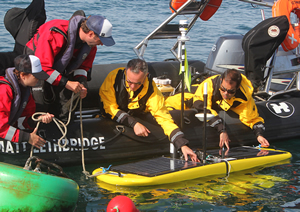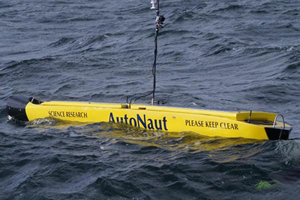Week One – What a week!
After heading out in the glorious late summer sunshine at the end of September, the fleet of robotic vehicles has had to endure two severe storms with 70mph winds and 20ft waves. During these storms the vehicles continued to collect valuable data, in conditions that would have forced research ships to return to port.
We have seen the first data coming back from the submarine gliders via satellite link, and they are already showing some interesting features. Measurements show that the ocean off southwest UK was a balmy 17°C at the surface in early October, dropping to a very cold 11°C at a depth of 45 metres. This strong temperature gradient is known as a thermocline, where a layer of warmer water sits over a layer of colder deeper water. This feature is seasonal, being best developed in mid-summer. The warm, settled weather in September means it has persisted into late autumn this year.
 The submarine glider data are also showing that plankton are concentrated at the thermocline, which would not be detected by satellites or surface vehicles. Other sensors on the gliders will soon tell us if these sub-surface plankton concentrations also attract higher densities of shoaling fish.
The submarine glider data are also showing that plankton are concentrated at the thermocline, which would not be detected by satellites or surface vehicles. Other sensors on the gliders will soon tell us if these sub-surface plankton concentrations also attract higher densities of shoaling fish.
Unfortunately we’ve also seen some technical problems, which has meant that two of the surface vehicles could not be sent offshore. In addition, one of the surface vehicles was damaged during a severe storm after a week out at sea, and has had to be recovered. With such an ambitious project we always knew that keeping all of the vehicles out in the ocean for the full duration was improbable.
So from an original fleet of seven there are now four vehicles remaining in the first phase of the campaign, although there may be a chance that one or two of the retired vehicles may be back in the game for the second phase later in the month.
Two surface vessels – AutoNaut, and a Waveglider that is operated by pilots in Liverpool and Southampton, have been making good progress towards an array of fixed moorings some 200km out to the southwest. One of the two submarine gliders has joined them.
 AutoNaut is carrying surface cameras and is towing a 25-metre hydrophone array at a depth of four metres. The vessel is thought to have snagged on floating mats of weed a couple of times, and we hope to confirm these when we recover the camera images. By turning AutoNaut through a circle, the pilots have easily escaped from these snags.
AutoNaut is carrying surface cameras and is towing a 25-metre hydrophone array at a depth of four metres. The vessel is thought to have snagged on floating mats of weed a couple of times, and we hope to confirm these when we recover the camera images. By turning AutoNaut through a circle, the pilots have easily escaped from these snags.
The other submarine glider has been sent eastwards on its own to undertake a profile across the Scilly front, which is a boundary between two water masses. This crossing should take three to four days, and will enable us to make a comparison with satellite imagery of the front. On completion of this task it will probably be sent southwest to join the rest of the fleet, but that decision will be taken nearer the time.
Being able to split the fleet means that we are able to maximise the data collected. Each vehicle has different capabilities and sensor loads. Identifying opportunities and solving technical problems is the reason we do trials like this – so much is learned about the vehicles during a real exercise. It has been good to hear lots of troubleshooting discussion and experience sharing between partners during the daily briefing sessions.
